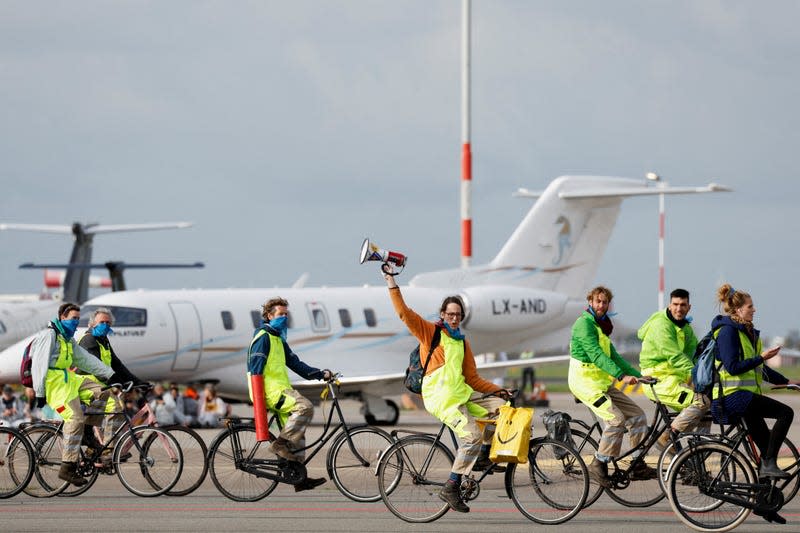Amsterdam’s Schiphol airport wants cleaner, quieter skies

An environmental protest on wheels at Schiphol airport.
Amsterdam’s Schiphol airport proposed a series of measures to reduce air traffic, carbon emissions, and noise pollution, including a proposed ban on private jets that could take effect as early as 2025.
The proposals also include a ban on flights late at night and in the early morning hours in order to cut noise disturbances, and stricter standards on aircraft that take off and land at the airport. Schiphol said in a statement that the new measures would “lead to quieter, cleaner, and better aviation.”
Read more
The airport intends to implement the changes no later than 2025 or 2026, and predicts the three measures will reduce noise nuisance by 16% and local residents’ sleep disturbances by 54%.
Schiphol is also scrapping its plans to build an additional runway, called Kaagbaan Runway, citing limited space in the area, and has earmarked €70 million ($76.7 million) for an environmental fund that will be invested into the local area until 2030.
Luchtverkeersleiding Nederland (LVNL), the Netherlands’ air traffic control agency, and Schiphol have been working in conjunction to reduce noise pollution in the area around the airport. The so-called “Minder hinder” (Dutch for “less hindrance”) program has already implemented a number of mitigation measures, including quiet braking at night and adjustments to flight routes.
The program conducted a public survey in 2020, soliciting feedback from residents living in the greater Schiphol area, and developed policies based on their nearly 1,000 responses. Currently, the program website shows over 40 other mitigation measures that are in progress, marked as being in either the research, evaluation, implementation, or design stages.
Quotable: “People first” at Schiphol airport
“The only way forward is to become quieter and cleaner more rapidly. We have thought about growth but too little about its impact for too long. We need to be sustainable for our employees, the local environment and the world.” —A statement from Ruud Sondag, CEO of the Royal Schiphol Group
Schiphol Airport is hub for private aviation
Schiphol ranked as the fourth-busiest airport in Europe in 2022, facilitating transit for 52.5 million passengers. It was also a busy hub for private flyers.
According to a recent study (pdf) commissioned by Greenpeace and conducted by CE Delft, a Dutch environmental consultant, Schiphol ranked as Europe’s most-used airport for private aviation from 2020 to 2022, with most private flyers jetting between London and Amsterdam. In 2022, over 6,700 private flights departed from Schiphol.
Private aircraft emissions at Schiphol have skyrocketed 683% from 2020 to 2022, increasing from 6,763 metric tons to 52,923 metric tons.
Amsterdam’s battle to reduce aviation emissions
The Dutch government has been seeking to cap the country’s annual flight volumes in pursuit of its climate goals. The aviation industry has not taken the new policies lying down.
A legal face off between the Dutch government and airline industry was resolved today (Apr. 5) with the Noord-Holland court ruling against the state’s plans to place a lower cap on flight volume at Schiphol airport.
Last month, the Dutch government announced a plan called “Preliminary Scheme Schiphol.” It proposed to cut the airport’s annual number of flights from 500,000, where they are currently capped, to 460,000 beginning in November 2023. The state’s final goal is to reach a 440,000 flight cap in 2024.
A group of airlines including KLM, Delta and easJet sued the government over the flight cap, arguing it violated European and international law, and would have a negative impact on customers and the economy.
Today’s ruling found that the Dutch government did not follow the correct procedure in implementing the 460,000 flight cap: “According to European rules, the State can only reduce the number of air transport movements at an airport after going through a careful process.”
The Dutch government’s plans to cut carbon emissions through restrictions on international flights has caused broader concern in the airline industry. In March, KLM, the country’s flagship carrier, told CNN: “Being the only country in the world to set up a national CO2-ceiling does not match with an internationally operating sector and international policy.”
Nevertheless, the Dutch government has started the EU process to approve its 440,000 flight cap. If it is successful, the contraction will be legally valid, according to the Dutch court.
Related stories
🛫 Private jet pollution in Europe has skyrocketed 855% since the pandemic
✈️ India has a $12 billion plan to keep up with soaring air travel
🔊 Paris will try using sound sensors to fine vehicles causing noise pollution
More from Quartz
The split of the African plate could gift six landlocked countries a coastline
How Credit Suisse’s demise strengthens Switzerland’s place in global finance
Sign up for Quartz's Newsletter. For the latest news, Facebook, Twitter and Instagram.


